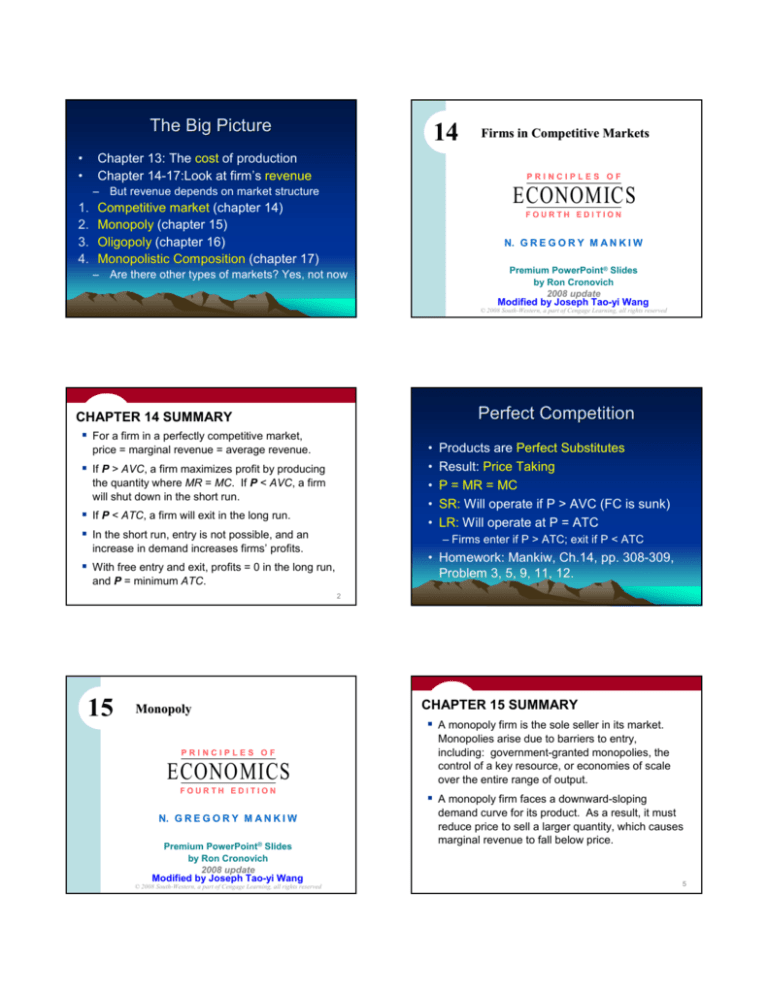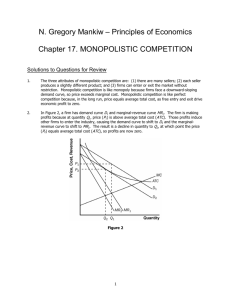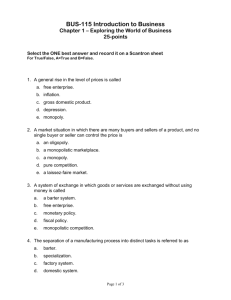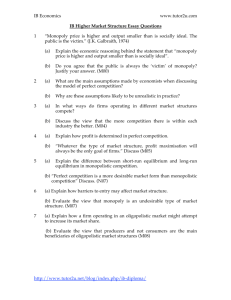
The Big Picture
•
•
14
Chapter 13: The cost of production
Chapter 14-17:Look at firm’s revenue
PRINCIPLES OF
ECONOMICS
– But revenue depends on market structure
1.
2.
3.
4.
Firms in Competitive Markets
Competitive market (chapter 14)
Monopoly (chapter 15)
Oligopoly (chapter 16)
Monopolistic Composition (chapter 17)
FOURTH EDITION
N. G R E G O R Y M A N K I W
Premium PowerPoint® Slides
by Ron Cronovich
2008 update
Modified by Joseph Tao-yi Wang
– Are there other types of markets? Yes, not now
© 2008 South-Western, a part of Cengage Learning, all rights reserved
Perfect Competition
CHAPTER 14 SUMMARY
For a firm in a perfectly competitive market,
•
•
•
•
•
price = marginal revenue = average revenue.
If P > AVC, a firm maximizes profit by producing
the quantity where MR = MC. If P < AVC, a firm
will shut down in the short run.
If P < ATC, a firm will exit in the long run.
In the short run, entry is not possible, and an
Products are Perfect Substitutes
Result: Price Taking
P = MR = MC
SR: Will operate if P > AVC (FC is sunk)
LR: Will operate at P = ATC
– Firms enter if P > ATC; exit if P < ATC
increase in demand increases firms’ profits.
• Homework: Mankiw, Ch.14, pp. 308-309,
Problem 3, 5, 9, 11, 12.
With free entry and exit, profits = 0 in the long run,
and P = minimum ATC.
2
15
Monopoly
PRINCIPLES OF
ECONOMICS
FOURTH EDITION
N. G R E G O R Y M A N K I W
Premium PowerPoint® Slides
by Ron Cronovich
2008 update
Modified by Joseph Tao-yi Wang
© 2008 South-Western, a part of Cengage Learning, all rights reserved
CHAPTER 15 SUMMARY
A monopoly firm is the sole seller in its market.
Monopolies arise due to barriers to entry,
including: government-granted monopolies, the
control of a key resource, or economies of scale
over the entire range of output.
A monopoly firm faces a downward-sloping
demand curve for its product. As a result, it must
reduce price to sell a larger quantity, which causes
marginal revenue to fall below price.
5
CHAPTER 15 SUMMARY
Monopoly firms maximize profits by producing the
CHAPTER 15 SUMMARY
Monopoly firms (and others with market power) try
quantity where marginal revenue equals marginal
cost. But since marginal revenue is less than
price, the monopoly price will be greater than
marginal cost, leading to a deadweight loss.
to raise their profits by charging higher prices to
consumers with higher willingness to pay. This
practice is called price discrimination.
Policymakers may respond by regulating
monopolies, using antitrust laws to promote
competition, or by taking over the monopoly and
running it. Due to problems with each of these
options, the best option may be to take no action,
Or, just auction off the market. (Demsetz, 1968)
6
7
Monopoly Market: Demand
Monopoly
120
100
• MR=MC to maximize profit (still true!)
• But, P < MR (D - downward sloping)
• Welfare Cost of a Monopoly:
– Profits (unfair??) vs. DWL (efficiency loss!!)
• Cures? Do nothing? Auction off the market
• Homework: Mankiw, Ch. 15,
Price
80
60
40
20
– Graph and Words: Problem 2, 3, 7, 8, 14
– Numerical: Problem 6, 8, 13
0
1
2
3
4
5
6
7
8
9 10 11 12 13 14 15 16 17 18 19 20 21 22 23 24
Quantity
Monopoly
16
120
100
Oligopoly
80
PRINCIPLES OF
60
Demand
Price
40
MR
20
MC
0
-20
ECONOMICS
FOURTH EDITION
Price
1
3
5
7
9
11
13
-40
15
17
19
21
23
N. G R E G O R Y M A N K I W
Premium PowerPoint® Slides
by Ron Cronovich
2008 update
Modified by Joseph Tao-yi Wang
-60
-80
Quantity
© 2008 South-Western, a part of Cengage Learning, all rights reserved
CHAPTER 16 SUMMARY
Oligopolists can maximize profits if they form a
CHAPTER 16 SUMMARY
The prisoners’ dilemma shows that self-interest
cartel and act like a monopolist.
can prevent people from cooperating, even when
cooperation is in their mutual interest. The logic of
the prisoners’ dilemma applies in many situations.
Yet, self-interest leads each oligopolist to a higher
quantity and lower price than under the monopoly
outcome.
Policymakers use the antitrust laws to prevent
oligopolies from engaging in anticompetitive
behavior such as price-fixing. But the application
of these laws is sometimes controversial.
The larger the number of firms, the closer will be
the quantity and price to the levels that would
prevail under competition.
12
Oligopoly
13
17
Monopolistic Competition
• When there are only a few firms
• Firms care about each other’s actions
PRINCIPLES OF
ECONOMICS
– Game Theory; Nash Equilibrium; P.D.
• Collusion (Monopoly) vs. Self-Interest
• Policy: Increase competition; antitrust
• Homework: Mankiw, Ch. 16, pp.368-371
Problem 3, 4, 6, 9, 10, 11
FOURTH EDITION
N. G R E G O R Y M A N K I W
Premium PowerPoint® Slides
by Ron Cronovich
2008 update
Modified by Joseph Tao-yi Wang
© 2008 South-Western, a part of Cengage Learning, all rights reserved
Introduction to Monopolistic Competition
In this chapter, look for the answers to
these questions:
How is monopolistic competition similar to perfect
Monopolistic competition:
a market structure in which many firms sell
products that are similar but not identical.
competition? How is it similar to monopoly?
How do monopolistically competitive firms choose
Recall:
price and quantity? Do they earn economic profit?
• Perfect competition = perfect substitutes
• Monopoly = no close substitutes
In what ways does monopolistic competition affect
society’s welfare?
Monopolistic competition
What are the social costs and benefits of
advertising?
CHAPTER 17
MONOPOLISTIC COMPETITION
= Partial Substitutes!
16
CHAPTER 17
MONOPOLISTIC COMPETITION
17
Introduction to Monopolistic Competition
Comparing Perfect & Monop. Competition
Differentiated Products:
perfect
competition
• Location, location, location! (產品定位)
Examples:
• apartments
• books
• bottled water
• clothing
• fast food
• night clubs
CHAPTER 17
18
number of sellers
one
many
free entry/exit
no
yes
long-run econ. profits
positive
zero
firm has market power?
yes
yes
D curve facing firm
downwarddownwardsloping
sloping
(market demand)
close substitutes
none
yes
yes
long-run econ. profits
zero
zero
the products firms sell
identical
differentiated
20
profit
Comparing Oligopoly & Monop. Competition
oligopoly
few
monopolistic
competition
many
importance of strategic
high
interactions between firms
low
likelihood of fierce
competition
high
CHAPTER 17
low?!
21
MONOPOLISTIC COMPETITION
For this firm,
P < ATC
at the output where
MR = MC.
MC
ATC
P
The best this firm
can do is to
minimize its losses.
ATC
MONOPOLISTIC COMPETITION
19
MONOPOLISTIC COMPETITION
A Monopolistically Competitive Firm
With Losses in the Short Run
Price
The firm uses the
D curve to set P.
CHAPTER 17
downwardsloping
horizontal
many
A Monopolistically Competitive Firm
Earning Profits in the Short Run
CHAPTER 17
free entry/exit
number of sellers
MONOPOLISTIC COMPETITION
To maximize profit,
firm produces Q
where MR = MC.
many
monopolistic
competition
monopoly
At each Q, MR < P.
many
D curve facing firm
MONOPOLISTIC COMPETITION
The firm faces a
downward-sloping
D curve.
number of sellers
firm has market power? none, price-taker yes
Comparing Monopoly & Monop. Competition
CHAPTER 17
monopolistic
competition
D
Price
MC
losses
ATC
ATC
P
D
MR
MR
Q
Q
Quantity
22
CHAPTER 17
MONOPOLISTIC COMPETITION
Quantity
23
Monopolistic Competition and Monopoly
A Monopolistic Competitor in the Long Run
Short run: Under monopolistic competition,
firm behavior is very similar to monopoly.
Long run: In monopolistic competition,
entry and exit drive economic profit to zero.
• If profits in the short run:
New firms enter market,
taking some demand away from existing firms,
prices and profits fall.
• If losses in the short run:
Some firms exit the market,
remaining firms enjoy higher demand and prices.
CHAPTER 17
MONOPOLISTIC COMPETITION
24
Why Monopolistic Competition Is
Less Efficient than Perfect Competition
CHAPTER 17
MC
ATC
P = ATC
markup
D
MC
MR
Q
Quantity
MONOPOLISTIC COMPETITION
25
Monopolistically competitive markets do not
have all the desirable welfare properties of
perfectly competitive markets.
• The monopolistic competitor operates on the
downward-sloping part of its ATC curve,
produces less than the cost-minimizing output.
Because P > MC, the market quantity is below
the socially efficient quantity.
• Under perfect competition, firms produce the
Yet, not easy for policymakers to fix this
quantity that minimizes ATC.
problem: Firms earn zero profits, so cannot
require them
to reduce prices.
2. Markup over marginal cost
• Under monopolistic competition, P > MC.
• Under perfect competition, P = MC.
MONOPOLISTIC COMPETITION
Notice that the
firm charges a
markup of price
over marginal
cost, and does
not produce at
minimum ATC.
Price
Monopolistic Competition and Welfare
1. Excess capacity
CHAPTER 17
Entry and exit
occurs until
P = ATC and
profit = zero.
(Is this the “best” we can do? Maybe!)
26
CHAPTER 17
MONOPOLISTIC COMPETITION
27
Advertising
Monopolistic Competition and Welfare
Number of firms in the market may not be optimal,
In monopolistically competitive industries,
due to external effects from the entry of new firms:
• the product-variety externality:
surplus consumers get from the introduction
of new products
• the business-stealing externality:
losses incurred by existing firms
when new firms enter market
product differentiation and markup pricing
lead naturally to the use of advertising.
In general, the more differentiated the products,
the more advertising firms buy.
Economists disagree about the social value of
advertising.
The inefficiencies of monopolistic competition are
subtle and hard to measure. No easy way for
policymakers to improve the market outcome.
CHAPTER 17
MONOPOLISTIC COMPETITION
28
CHAPTER 17
MONOPOLISTIC COMPETITION
29
The Critique of Advertising
The Defense of Advertising
Critics of advertising believe:
• Society is wasting the resources it devotes to
Defenders of advertising believe:
• It provides useful information to buyers.
• Informed buyers can more easily find and
advertising.
• Firms advertise to manipulate people’s tastes.
• Advertising impedes competition –
exploit price differences.
• Thus, advertising promotes competition and
reduces market power.
it creates the perception that products are
more differentiated than they really are,
allowing higher markups.
CHAPTER 17
MONOPOLISTIC COMPETITION
Results of a prominent study:
Eyeglasses were more expensive in states
that prohibited advertising by eyeglass makers
than in states that did not restrict such advertising.
30
CHAPTER 17
MONOPOLISTIC COMPETITION
31
Brand Names
Advertising as a Signal of Quality
In many markets, brand name products coexist
A firm’s willingness to spend huge amounts
on advertising may signal the quality of its product
to consumers, regardless of the content of ads.
with generic ones.
Firms with brand names usually spend more on
• Ads may convince buyers to try a product once,
advertising, charge higher prices for the products.
but the product must be of high quality for people
to become repeat buyers.
As with advertising, there is disagreement about
the economics of brand names…
• The most expensive ads are not worthwhile
unless they lead to repeat buyers.
• When consumers see expensive ads,
they think the product must be good if the company
is willing to spend so much on advertising.
CHAPTER 17
MONOPOLISTIC COMPETITION
32
The Critique of Brand Names
CHAPTER 17
MONOPOLISTIC COMPETITION
33
The Defense of Brand Names
Critics of brand names believe:
• Brand names cause consumers to perceive
Defenders of brand names believe:
• Brand names provide information about quality
differences that do not really exist.
to consumers.
• Consumers’ willingness to pay more for brand
• Companies with brand names have incentive
names is irrational, fostered by advertising.
to maintain quality, to protect the reputation of
their brand names.
• Eliminating govt protection of trademarks
would reduce influence of brand names,
result in lower prices.
CHAPTER 17
MONOPOLISTIC COMPETITION
34
CHAPTER 17
MONOPOLISTIC COMPETITION
35
CONCLUSION
CHAPTER SUMMARY
A monopolistically competitive market has
Differentiated products are everywhere;
examples of monopolistic competition abound.
many firms, differentiated products, and free entry.
The theory of monopolistic competition
Each firm in a monopolistically competitive market
describes many markets in the economy,
yet offers little guidance to policymakers looking
to improve the market’s allocation of resources.
CHAPTER 17
MONOPOLISTIC COMPETITION
has excess capacity – produces less than the
quantity that minimizes ATC. Each firm charges a
price above marginal cost.
36
CHAPTER SUMMARY
Monopolistic competition does not have all of the
MONOPOLISTIC COMPETITION
Monopolistic Competition
• Most close to reality
• Differentiated Products:
– Location, location, location!
• SR: Like a monopoly (locally)
• LR: Zero profits
• Homework: Mankiw, Ch.17, pp. 388-389,
Problem 5, 6, 7, 8, 9
MONOPOLISTIC COMPETITION
37
CHAPTER SUMMARY
Product differentiation and markup pricing lead to
desirable welfare properties of perfect competition.
There is a deadweight loss caused by the markup
of price over marginal cost. Also, the number of
firms (and thus varieties) can be too large or too
small. There is no clear way for policymakers to
improve the market outcome.
CHAPTER 17
CHAPTER 17
38
the use of advertising and brand names. Critics of
advertising and brand names argue that firms use
them to reduce competition and take advantage of
consumer irrationality. Defenders argue that firms
use them to inform consumers and to compete
more vigorously on price and product quality.
CHAPTER 17
MONOPOLISTIC COMPETITION
39










